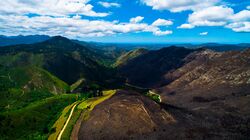Lab-0024: Difference between revisions
From CSDMS
No edit summary |
No edit summary |
||
| Line 7: | Line 7: | ||
|LabModelDocumentation=SPACE | |LabModelDocumentation=SPACE | ||
|LabAssociatedLesson=Jupyter Notebook | |LabAssociatedLesson=Jupyter Notebook | ||
|LabURLStartNotebook=https:// | |LabURLStartNotebook=https://jupyter.openearthscape.org/hub/user-redirect/git-pull?repo=https%3A%2F%2Fgithub.com%2Fjkpierce%2Ffirescapes&urlpath=tree%2Ffirescapes%2Ffires_sediment.ipynb&branch=main | ||
|LabURL2StartNotebook=https://lab.openearthscape.org/hub/user-redirect/git-pull?repo=https%3A%2F%2Fgithub.com%2Fjkpierce%2Ffirescapes&urlpath=tree%2Ffirescapes%2Ffires_sediment.ipynb&branch=main | |||
}} | }} | ||
{{LabContributorData | {{LabContributorData | ||
| Line 30: | Line 31: | ||
{{LabClassroomOrganization | {{LabClassroomOrganization | ||
|LabCOIntro=This Jupyter Notebook is best for people who already have a conceptual understanding of earth surface processes and want to learn how these apply to numerical modeling, landscape evolution, and sediment flux. Although no Python skills are required to run the notebook, those with an intermediate understanding of Python will be able to learn more by reading the code. | |LabCOIntro=This Jupyter Notebook is best for people who already have a conceptual understanding of earth surface processes and want to learn how these apply to numerical modeling, landscape evolution, and sediment flux. Although no Python skills are required to run the notebook, those with an intermediate understanding of Python will be able to learn more by reading the code. | ||
}} | }} | ||
{{LabLearningObjectivesSkills | {{LabLearningObjectivesSkills | ||
| Line 59: | Line 55: | ||
}} | }} | ||
{{LabNotes | {{LabNotes | ||
|LabNotesInstructions= | |LabNotesInstructions=<p>This lab can be run on the <em>lab</em> (for educators) and <em>jupyter</em> (for general use) instances of the OpenEarthscape JupyterHub: just click one of the links under the <strong>Run online using</strong> heading at the top of this page, then run the notebook in the "CSDMS" kernel.</p> | ||
<p>If you don't already have a JupyterHub account, follow the instructions to sign up at https://csdms.colorado.edu/wiki/JupyterHub. If you're an educator, you can get JupyterHub accounts for students--please contact us through the CSDMS Help Desk: https://csdms.github.io/help-desk.</p> | |||
|LabAcknowledgements=This lab was created during CSDMS's ESPIn 2021 summer workshop. Thank you to everyone involved in organizing and teaching ESPIn. | |LabAcknowledgements=This lab was created during CSDMS's ESPIn 2021 summer workshop. Thank you to everyone involved in organizing and teaching ESPIn. | ||
}} | }} | ||
| Line 67: | Line 65: | ||
{{LabReferences | {{LabReferences | ||
|LabReferences=Shobe, C. M., Tucker, G. E., and Barnhart, K. R.: The SPACE 1.0 model: a Landlab component for 2-D calculation of sediment transport, bedrock erosion, and landscape evolution, Geosci. Model Dev., 10, 4577–4604, https://doi.org/10.5194/gmd-10-4577-2017, 2017. | |LabReferences=Shobe, C. M., Tucker, G. E., and Barnhart, K. R.: The SPACE 1.0 model: a Landlab component for 2-D calculation of sediment transport, bedrock erosion, and landscape evolution, Geosci. Model Dev., 10, 4577–4604, https://doi.org/10.5194/gmd-10-4577-2017, 2017. | ||
}} | |||
{{LabReferences | |||
|LabReferences=Campforts, B., Overeem, I., Gasparini, N.M., Piper, M., and Arthurs, L., 2021: Modeling earth surface processes for the future: ESPIn, a summer school focusing on cyber training and professional networking, 2021 AGU Fall Meeting, New Orleans, LA. | |||
}} | }} | ||
Revision as of 16:04, 19 April 2022
Including wildfires in a landscape evolution model
Contributor(s)
Kevin Pierce at University of British Columbia.
Laurent Roberge at Tulane University.
Nishani Moragoda at University of Alabama.
Introduction
This lab is appropriate for advanced undergraduates and graduate students majoring in earth science/engineering.
Classroom organization
This Jupyter Notebook is best for people who already have a conceptual understanding of earth surface processes and want to learn how these apply to numerical modeling, landscape evolution, and sediment flux. Although no Python skills are required to run the notebook, those with an intermediate understanding of Python will be able to learn more by reading the code.
Learning objectives
Skills
Skills
- Use Landlab to generate a grid
- Use Fastscape and SPACE for landscape evolution
- Create plots
Key concepts
- Landscape evolution
- Stream Power equation
- Wildfires
- Sediment flux
Lab notes
This lab can be run on the lab (for educators) and jupyter (for general use) instances of the OpenEarthscape JupyterHub: just click one of the links under the Run online using heading at the top of this page, then run the notebook in the "CSDMS" kernel.
If you don't already have a JupyterHub account, follow the instructions to sign up at https://csdms.colorado.edu/wiki/JupyterHub. If you're an educator, you can get JupyterHub accounts for students--please contact us through the CSDMS Help Desk: https://csdms.github.io/help-desk.
Acknowledgements
This lab was created during CSDMS's ESPIn 2021 summer workshop. Thank you to everyone involved in organizing and teaching ESPIn.
References
- Braun, J., Willett, S. (2013). A very efficient O(n), implicit and parallel method to solve the stream power equation governing fluvial incision and landscape evolution. Geomorphology 180-181(C), 170-179. https://dx.doi.org/10.1016/j.geomorph.2012.10.008
- Shobe, C. M., Tucker, G. E., and Barnhart, K. R.: The SPACE 1.0 model: a Landlab component for 2-D calculation of sediment transport, bedrock erosion, and landscape evolution, Geosci. Model Dev., 10, 4577–4604, https://doi.org/10.5194/gmd-10-4577-2017, 2017.
- Campforts, B., Overeem, I., Gasparini, N.M., Piper, M., and Arthurs, L., 2021: Modeling earth surface processes for the future: ESPIn, a summer school focusing on cyber training and professional networking, 2021 AGU Fall Meeting, New Orleans, LA.

